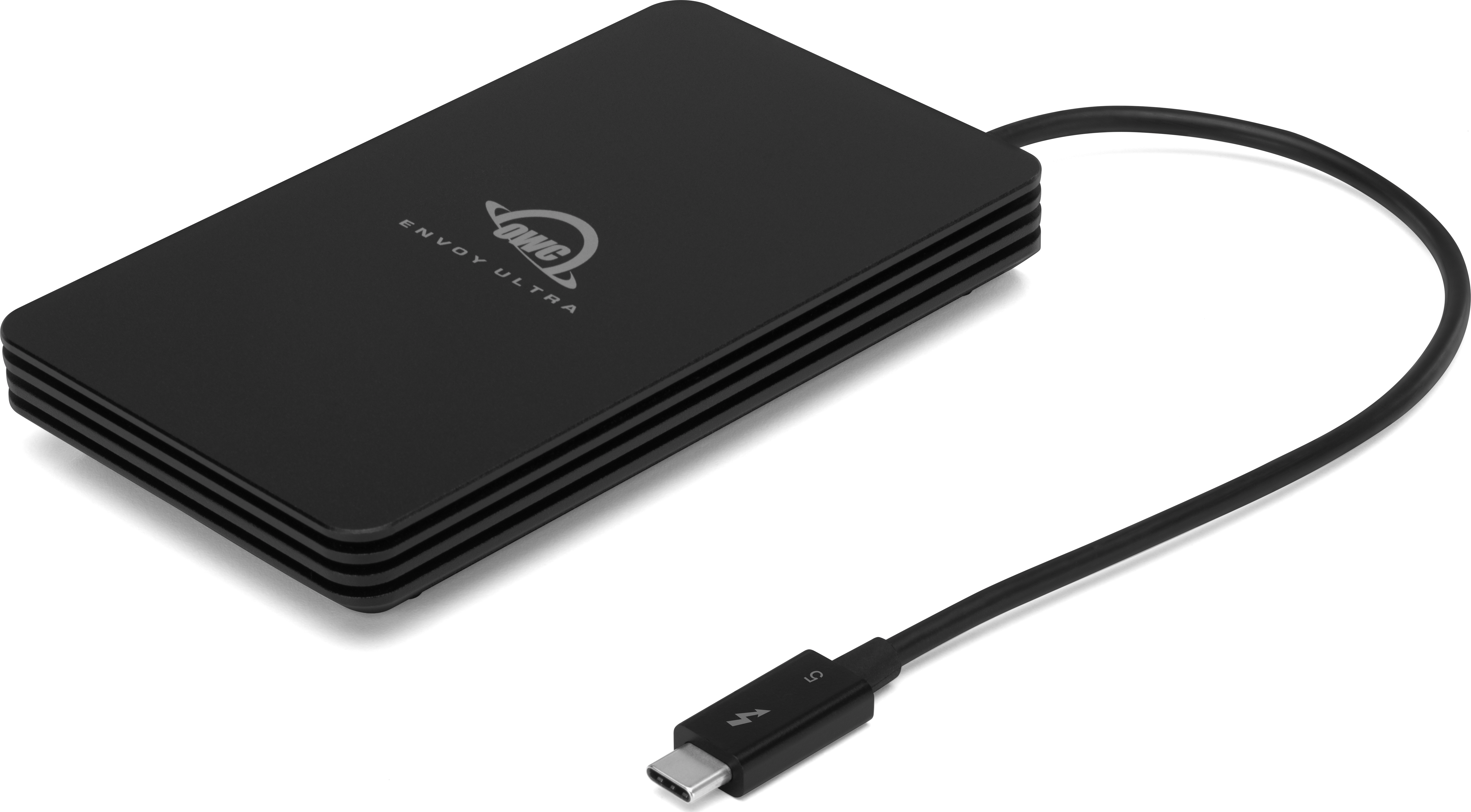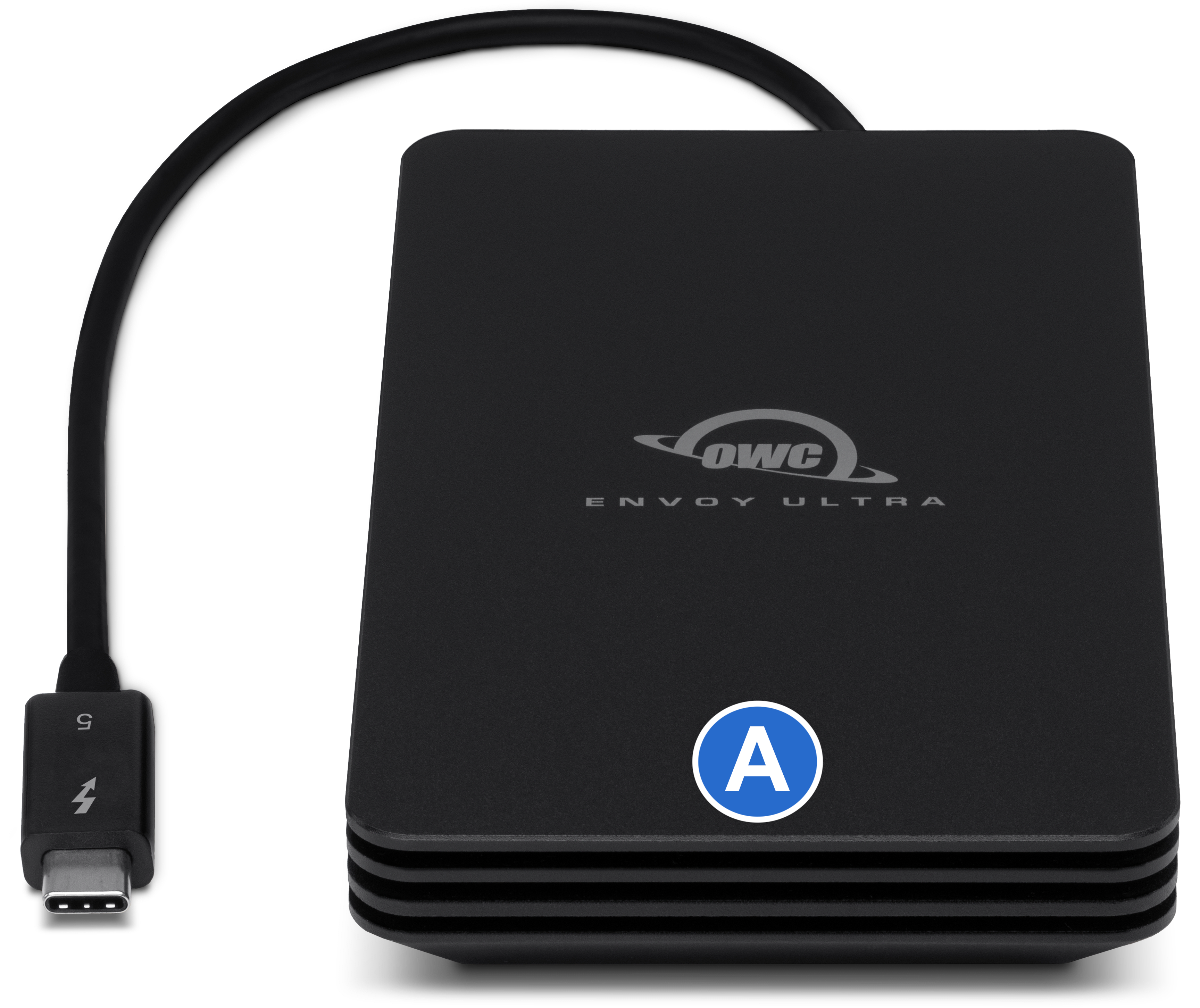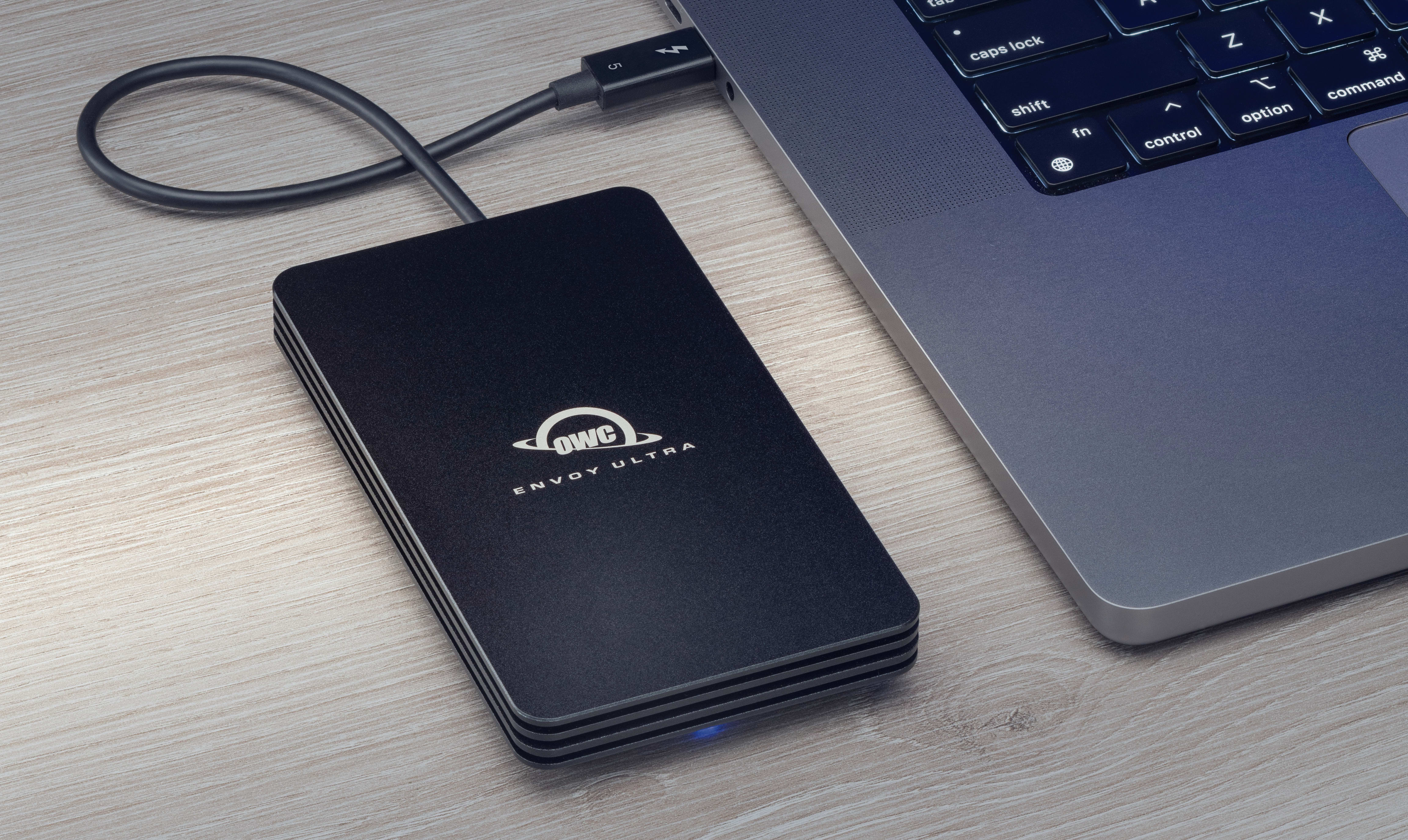OWC Envoy Ultra
Support Manual

Introduction
1.1 System Requirements
Operating System & Hardware
Works with any Thunderbolt 5 | Thunderbolt 4 | Thunderbolt 3 (Mac Only) | USB4 equipped:
- Mac: macOS 14.x or later
- Thunderbolt 5 requires macOS 15.3.x or later
- Thunderbolt 3 requires macOS 15.x or later
- Intel based systems require macOS 15.x or later
- PC: Windows 11 or later
- Chromebook: current Chrome OS version recommended
- iPad Pro: current iPadOS version recommended
- Linux: current Ubuntu version recommended
1.2 Package Contents
- (1) OWC Envoy Ultra Portable SSD
- (1) OWC Envoy Ultra Getting Started QR Insert Card
1.3 Overview
A. LED Indicator – Power and Data - Solid Blue | Disk Activity - Flashing Blue | Sleep - Solid Blue
B. Tethered Thunderbolt 5 Cable – Connect the cable to a compatible host.


Getting Started
2.1 Device Setup
This section describes the process of setting up the OWC Envoy Ultra.
1. Connect the tethered Thunderbolt 5 cable into a compatible host.

2. The OWC Envoy Ultra comes formatted as APFS for Mac systems. This allows for a seamless plug-and-play experience between Mac and iPad systems. Connect the OWC Envoy Ultra to a Mac or iPad and immediately begin using the drive.
- NOTE: Windows, ChromeOS, and Android users will need to reformat the Mac formatted OWC device over that operating system to begin use. Please consult the support article "OWC Drive Setup Over Non-Apple Platforms" for instructions regarding reformatting the OWC Envoy Pro FX to work with Windows, ChromeOS, or Android operating systems.
- NOTE: Please consult the Support Manual for OWC Drive Guide or Drive Guide Support Guide page for additional information regarding OWC Drive Guide.
Device Management
3.1 OWC Disk Performance
- As of Windows 10 v. 1809 the default Disk Removal Policy is ‘Quick removal’ instead of ‘Better performance’.
- NOTE: OWC storage solutions that are experiencing slow read/write speeds should consider checking and changing the Windows disk removal policy. Changing from "Quick removal" to "Better performance" can increase disk performance. OWC offers the application OWC Disk Performance to help change the Disk Removal Policy. Changing from "Quick removal" to "Better performance" can also be changed manually.
- Please review the support article Storage Solutions: OWC Disk Performance for more detail.
3.2 Manually Unmounting Volumes
To ensure no data is lost during normal use, always eject or unmount the corresponding volume(s) from the operating system before powering off and disconnecting the device. Unmounting options are provided below.
macOS
- Drag the icon for the device you wish to unmount to the trash can; OR
- Right-click the device icon on the desktop, then click “Eject”; OR
- Highlight the device on your Desktop and press Command-E.
Windows
- Windows 10 build 1809 (October 2018) or later:
- Eject the drive by clicking the ‘Show hidden items’ menu in the Taskbar, then clicking ‘Safely Remove Hardware and Eject Media’, and last select the ‘Eject’ option for this volume.
- Windows 10 build 1803 and earlier:
- Go to the System Tray (located in the lower right corner of your screen). Click on the “Eject” icon (a small green arrow over a hardware image).
- A message will appear, detailing the devices that the “Eject” icon controls, i.e., “Safely remove...” Click on this prompt.
- You will then see a message that says, “Safe to Remove Hardware.” It is now safe to disconnect the device from the computer.
3.3 Usage Notes
- Performance will vary depending on host hardware, usage, and the connection type being used to mount
- Prolonged use can cause the OWC Envoy Ultra to become warm. This is normal and doesn't impact performance.
- Does not mount if being connected as the third bus powered device with select Mac systems, including the Apple (M4) MacMini16,11 and Apple (M4 Max) Mac Studio
- Initial max data rates of up to over 6,000MB/s for continuous data read/write.
- Longer data write sessions will have reduced sustained write speeds. Read speeds remain consistently up to over 6,000MB/s.
- 2TB OWC Envoy Ultra - up to 1,350MB/s Write
- 4TB OWC Envoy Ultra - up to 1,700MB/s Write
- Longer data write sessions will have reduced sustained write speeds. Read speeds remain consistently up to over 6,000MB/s.
- The OWC Envoy Ultra may take up to 30 seconds or more to mount on iPadOS or Chrome OS.
PCs and Chromebook devices require a Thunderbolt 4 | Thunderbolt 5 | USB4 port to use the OWC Envoy Ultra.
Thunderbolt cable connector/plug end is not waterproof and must be dry/clean before connecting Envoy Ultra to a machine or device.
Support Resources
4.1 Troubleshooting
- Verify the OWC Envoy Ultra is securely connected to the host.
- Connect the OWC Envoy Ultra to a different host port or different host.
- The OWC Envoy Ultra LED blinks rapidly when not detected by the host. This may be an indication the host device does not provide enough bus power for the OWC Envoy Ultra to function. Try another port or host device.
- Users experiencing slow read/write speeds should consider checking and changing the Windows disk removal policy. Please review the support article Storage Solutions: OWC Disk Performance for more detail.
- We are very sorry If issues continue to occur. Please know that OWC support is here to help. Contact information for our support can be found in section 4.4 "Contacting Support". Please have your serial number ready which is located on the back of the OWC Envoy Ultra and printed on the original packaging.
4.2 Online Resources
4.3 About Data Backup
To ensure that your files are protected and to prevent data loss, we strongly suggest that you keep two copies of your data: one copy on your OWC Envoy Ultra and a second copy on either your internal drive or another storage medium, such as an optical backup, or on another external storage unit. Any data loss or corruption while using the OWC Envoy Ultra is the sole responsibility of the user, and under no circumstances may OWC, its parents, partners, affiliates, officers, employees, or agents be held liable for loss of the use of data including compensation of any kind or recovery of the data.
4.4 Contacting Support
4.5 About This Manual
The images and descriptions may vary slightly between this manual and the unit shipped. Functions and features may change depending on the firmware version. The OWC Envoy Ultra comes with a 5-Year Limited Warranty. Additional warranty information can be viewed by visiting Hardware Warranties.. OWC’s Limited Warranty is not transferable and subject to limitations.
General Use Precautions
- To avoid damage, do not expose the device to temperatures outside the following ranges:
- Environmental (Operating)
- Temperature (ºF): 41º — 95º
- Temperature (ºC): 5º — 35º
- Environmental (Non-Operating)
- Temperature (ºF): -4º — 140º
- Temperature (ºC): -20º — 60º
- Environmental (Operating)
- Always unplug the device from the electrical outlet if there is a risk of lightning or if it will be unused for an extended period-of-time. Otherwise, there is an increased risk of electrical shock, short-circuiting, or fire.
- Protect your device from excessive exposure to dust during use or storage. Dust can build up inside the device, increasing the risk of electrical shock, short-circuiting, or fire.
Safety Precautions
- Use proper anti-static precautions when handling this device. Failure to do so can increase the risk of electrical shock or short-circuiting.
- Never expose your device to rain, or use it near water, or in damp wet conditions. Never place objects containing liquids on the device, as they may spill everywhere and into the openings. This will increase the risk of electrical shock, short-circuiting, fire, or personal injury.
- To avoid any risk of electrical shock, short-circuiting, fire, or dangerous emissions, never insert any metallic object into the device.
- Please cease use of the device and contact OWC Support if it appears to be malfunctioning.
Terms & Conditions of Sale
Warranty
OWC’s products are subject to OWC’s Terms & Conditions of Sale located at Terms of Sale or other applicable terms. The OWC Envoy Ultra comes with a 5-Year Limited Warranty. Additional warranty information can be viewed by visiting Hardware Warranties.
Changes
The material in this document is for information purposes only and subject to change without notice. While reasonable efforts have been made in the preparation of this document to assure its accuracy, OWC, its parent, partners, affiliates, officers, employees, and agents assume no liability resulting from errors or omissions in this document, or from the use of the information contained herein. OWC reserves the right to make changes or revisions in the product design or the product manual without reservation and without obligation to notify any person of such revisions and changes.
FCC Statement
Warning! Modifications not authorized by the manufacturer may void the user’s authority to operate this device.
NOTE: This equipment has been tested and found to comply with the limits for a Class B digital device, pursuant to Part 15 of the FCC Rules. These limits are designed to provide reasonable protection against harmful interference in a residential installation. This equipment generates, uses and can radiate radio frequency energy and, if not installed and used in accordance with the instructions, may cause harmful interference to radio communications. However, there is no guarantee that interference will not occur in a particular installation. If this equipment does cause harmful interference with radio or television reception, which can be determined by turning the equipment off and on, the user is encouraged to try to correct the interference by one or more of the following measures:
- Reorient or relocate the receiving antenna.
- Increase the separation between the equipment and receiver.
- Connect the equipment to an outlet on a circuit different from that to which the receiver is connected.
Copyrights and Trademarks
© 2024 Other World Computing, Inc. All rights reserved. Envoy, OWC, and the OWC logo are trademarks of New Concepts Development Corporation, registered in the U.S. and/or other countries. Mac and macOS are trademarks of Apple Inc., registered in the U.S. and other countries. Thunderbolt and the Thunderbolt logo are trademarks of Intel Corporation in the U.S. and/or other countries. Other marks may be the trademark or registered trademark property of their owners.
No part of this publication may be reproduced, stored in a retrieval system, or transmitted in any form or by any means, electronic, mechanical, photocopying, recording or otherwise, without the prior written consent of OWC.
Free Support Chat
Our free award-winning support team is ready to answer all of your questions. Technical support is available Monday - Friday: 9AM - 6PM. Customer Support & Sales is available Monday - Friday: 9AM - 6PM. Support is unavailable on U.S. Federal holidays. Talk to a human today.

 1-800-275-4576
1-800-275-4576